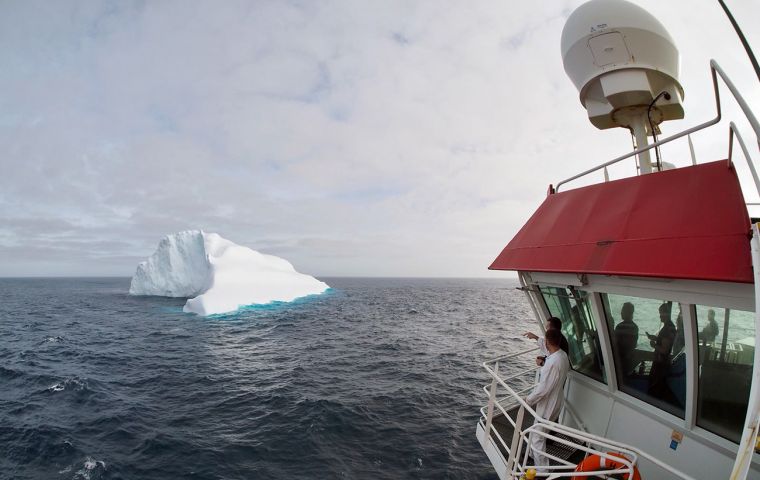MercoPress. South Atlantic News Agency
HMS Protector makes history: sails further north than any other Royal Navy ship
 The ship tested herself against various depths and types of ice, assisted by scientists
The ship tested herself against various depths and types of ice, assisted by scientists Icebreaker HMS Protector sailed closer to the North Pole than any other Royal Navy ship in history on her first patrol of the Arctic. The survey and research ship crunched her way through polar ice to within 1,050 kilometres of the top of the world as she gathered data about the ocean and environment.
Only submarines – such as HMS Trenchant which punched through the ice at the Pole in 2018 – can travel further north than the position the Plymouth-based survey ship reached: 80°41.5 North in the Greenland Sea.
Protector completed the most extensive overhaul in her decade-long career in the Royal Navy in January, since when she’s been conducting extensive trials and training – all intending to deploy to Antarctica in the autumn.
Having been nowhere near the ice in more than two years, the ship tested the strength of her engines using a specialist bollard pull in Flekkefjord, southern Norway, then began icebreaking in earnest in the Fram Strait – between Greenland and the Norwegian island chain of Svalbard.
The ship tested herself against various depths and types of ice, assisted by scientists, engineers and advisors including from the Ministry of Defense and the British Antarctic Survey.
Also helping the ship were two Royal Navy officers who sailed into the Alaskan Arctic aboard the US Coast Guard cutter Polar Star during the winter, and ice-breaking expert Lieutenant Lauren Kowalski, also from the US Coast Guard.
“This team has ventured far to one of the most amazing parts of the planet,” said Protector’s Commanding Officer Captain Michael Wood. “The chance to familiarize ourselves with this unforgiving environment has been fantastic, and re-asserts the UK’s ability to operate in the Arctic.”
The ship’s Royal Marines’ Mountain Leader Sergeant Chris Carlisle led daily patrols onto ice floes inhabited by polar bears to set up the trial ranges and take ice samples.
“The team adapted well to the Arctic,” he said. “Within a week of sailing from Devonport, the temperatures and conditions changed immeasurably. Everybody on-board proved they can safely do their job in the most extreme of environments.”
The ship also conducted surveys of the sea bed – between 2,000 and 3,000 meters deep in the Fram Strait – collected data about the North Atlantic currents observed marine mammals and helped the British Antarctic Survey with its work studying the polar ice cap.
Protector rounds off her mission to the High North by arriving in Reykjavik today to mark Iceland’s recent accession to the UK-led Joint Expeditionary Force, drawn from nine northern European nations committed to global security.
She’ll then return to Plymouth having earned her ‘ice credentials’ and begin preparing for the return to the southern polar region in the autumn, a mission Captain Wood says has added significance this year.
He continued: “We are ready to get back to Antarctica. In the year the UK hosts the COP 26 Conference, our commitment to preserving and understanding this pristine continent, and the impact of climate change upon it, is more important than ever.”




Top Comments
Disclaimer & comment rulesCommenting for this story is now closed.
If you have a Facebook account, become a fan and comment on our Facebook Page!